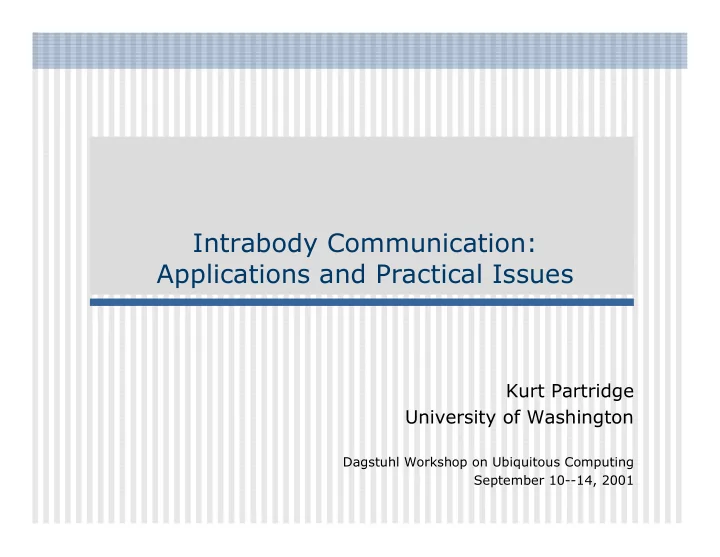

Intrabody Communication: Applications and Practical Issues Kurt Partridge University of Washington Dagstuhl Workshop on Ubiquitous Computing September 10--14, 2001
What is Intrabody Communication? ! Low power electrical signals sent through the human body ! Allows ubiquitous and wearable devices to communicate ! The big benefit: signal stays very close to the body 2
Motivating Ubicomp Scenario: User Association UI Data IO Appliance UI Data IO Appliance UI Data IO Appliance UI Data IO Appliance 3
Motivating Ubicomp Scenario: User Association UI Data IO Appliance UI Data IO Appliance UI Data IO Appliance UI Data IO Appliance 4
Basic Principles 5
Principles Applied transmit receive + - - + + - V out 6
Our Implementation ! Size: 8cm x 13cm ! Power: 4 9V batteries ! Data rate: 56 kbps ! Data encoding: FSK ! Frequencies: 140 kHz and 180 kHz ! TX voltage swing: 20V peak-to-peak 7
Basic Experiment Setup 8
Coupling to the Body Wrist Strap Belt Shoe 9
Findings ! Minimum signal amplitude for communication: 20 mV 10
Other Situations 11
Communication without Touch ! Non-touch communication is undesirable, but it happens ! One trick: reducing transmit voltage ! Works with the shoe ! Doesn’t work with wrist and belt because of ground plate impedance variations 12
Other Experiments Experiment Result 2-5 times weaker ! Raising shoe signal large plates roughly ! Changing grounding similar plate size 1-2 times weaker ! Gloves little difference ! Barefoot distinguished well ! Multiple transmitters 13
Theoretical Maximum BW ! Hartley-Shannon Law: max. error-free capacity: capacity = bandwidth * log 2 (1 + SNR) Megabits/sec Bandwidth (kHz) SNR (in dB) 14
Application Taxonomy 1. Personal Area Networks 2. Collect Data from Environment 3. Customize Environment on per user basis 4. Customize Environment on per user task basis 15
Competing Technologies Method Examples Features short-range Bluetooth, RF Ok for PAN, prob w/multiple RF Monolithics people, eavesdropping infrared IR badges, Problems outdoors, greater Eye-R power, less intentional ID at physical password, Passive, customization user-interface iButtons, RFID, stored with device, privacy fingerprint, issues, administrative and barcode operational overhead, less inconspicuous 16
Health Concerns ! Short term: ! Shock – unlikely ! Pacemakers – may be affected ! Long term: ! Cancer – difficult to predict, similar to power-line studies ! Other effects -- unknown 17
Future Goals ! Achieve touch-only communication ! Increase speed ! Build a deployable board ! Evaluate in practical environment 18
Conclusions ! Intrabody communication may provide ubicomp with touch-selective communication ! Watch for new results over the next several months ! Visit us on the web at: http://portolano.cs.washington.edu/projects/contact 19
Other Findings ! Using the other hand with the wrist coupler reduced signal strength by 0.5 ! A portable PDA has a weaker signal, but was position-dependent ! Grounding or putting a conductive plate down helps a lot ! Touching both xmit plates generates a strong signal w/wrist and belt only 20
Motivating Ubicomp Scenario: User Association UI Data IO Appliance 21
Motivating Ubicomp Scenario: User Association UI Data IO Appliance 22
Basic Principles 23
Recommend
More recommend